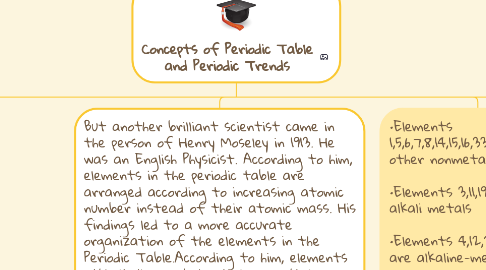Concepts of Periodic Table and Periodic Trends
by Khate Hasley Sibug

1. The periodic table consists of a total of 118 items. Each box has an element which is represented by a symbol and consists of the atomic mass and its atomic number.
1.1. The two divisions of Periodic Table
1.1.1. Period or the rows and Group or the columns.
1.1.2. These elements are arranged by increasing atomic mass.
2. The Periodic Table
2.1. The Development of the Periodic Table started with Johanns Wolfgang Dobereiner in 1829, a German Chemist. He found out that elements in the Periodic Table are arranged into sets of triads. Groups could be composed of three elements in which all the elements shared identical physical and chemical properties. He called it the Dobereiner’s Triad. But John Alexander Newlands modified its arrangements in year 1864 a British chemist. He arranged the elements in the Periodic Table into a seven-element interval called the Law of Octaves.
2.2. According to him, elements with similar and chemical properties occur after each interval of seven elements. Until In 1869, a Russian Chemist named Dmitri Mendeleev made another arrangement of the elements. He realized that the physical and chemical properties of elements were related to their atomic mass in a 'periodic' way, and he arranged them so that groups of elements with similar properties fell into vertical columns in his table. His arrangement was accepted and he was now known as the Father of Modern Periodic Table.
3. But another brilliant scientist came in the person of Henry Moseley in 1913. He was an English Physicist. According to him, elements in the periodic table are arranged according to increasing atomic number instead of their atomic mass. His findings led to a more accurate organization of the elements in the Periodic Table.According to him, elements with similar and chemical properties occur after each interval of seven elements. Until In 1869, a Russian Chemist named Dmitri Mendeleev made another arrangement of the elements.
3.1. He realized that the physical and chemical properties of elements were related to their atomic mass in a 'periodic' way, and he arranged them so that groups of elements with similar properties fell into vertical columns in his table. His arrangement was accepted and he was now known as the Father of Modern Periodic Table. But another brilliant scientist came in the person of Henry Moseley in 1913. He was an English Physicist. According to him, elements in the periodic table are arranged according to increasing atomic number instead of their atomic mass. His findings led to a more accurate organization of the elements in the Periodic Table.
4. •Elements 1,5,6,7,8,14,15,16,33,34,52 are other nonmetals •Elements 3,11,19,37,55,87 are alkali metals •Elements 4,12,20,38,56,88 are alkaline-metals •Elements 21,39,57-71 are rare-earth elements and lanthanoid elements (57-71 only)
4.1. •Elements 22-30,40-48,72-80,104-112 only are the transition metals •Elements 13,31,32,49-51,81-84,113-116 are other metals •Elements 9,17,35,53,85,117 are halogens •Elements 2,10,18,36,54,86,118 are noble gas •Elements 89, 90-103 are actinoid elements
5. The Periodic Trends
5.1. The atomic radius is one-half the distance between the nuclei of two atoms
5.2. Atomic radius decreases from left to right
5.3. Atomic radius increases from top to bottom
5.4. Electronegativity measures an atom's tendency to attract and form bonds with electrons.
5.5. From left to right across a period of elements, electronegativity increases.
5.6. From top to bottom down a group, electronegativity decreases.
5.7. Ionization energy is the energy required to remove an electron from a neutral atom in its gaseous phase.
5.8. Ionization energy increases from left to right on the periodic table.
5.9. The ionization energy of the elements within a group generally decreases from top to bottom.
5.10. Electron affinity is the ability of an atom to accept an electron
5.11. Electron affinity increases from left to right within a period.
5.12. Electron affinity decreases from top to bottom within a group.
6. Electronic Configuration
6.1. Electric configuration is the arrangement of electrons in energy levels around an atomic nucleus. Commonly, the electron configuration is used to describe the orbitals of and atom in its ground state, but it can also be used to present an atom that has ionized into a cation or anion by compensatingwith the loss of or gain of electrons in their subsequent orbitals. Electric configuration gives us better understanding of its bonding, abilty, magnetism,. When assigning electrons to orbitals we must set of three rules: the aufbaw principle, pauli exclusion, principle and hand's rule


